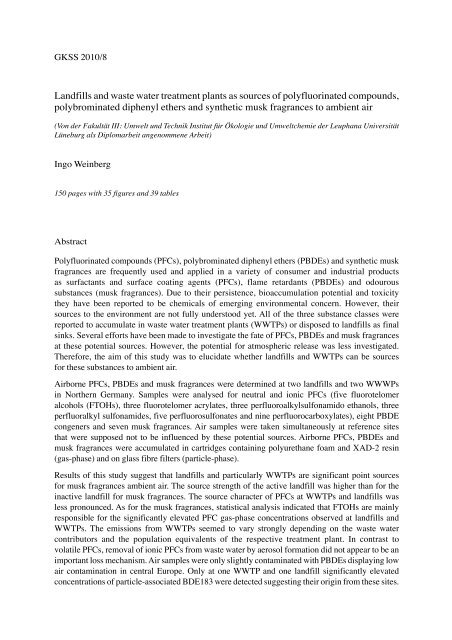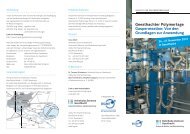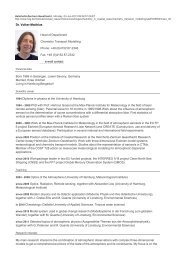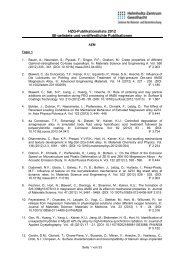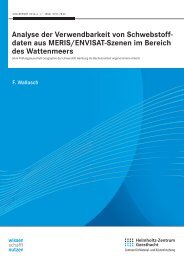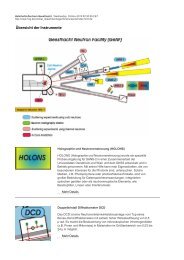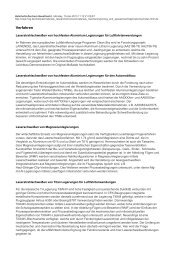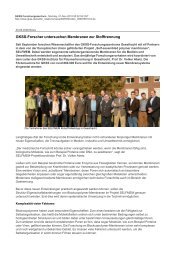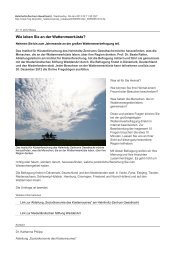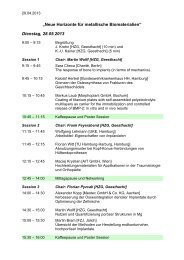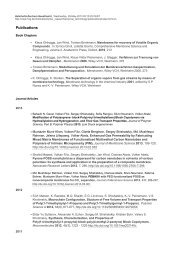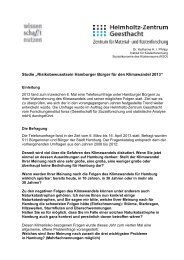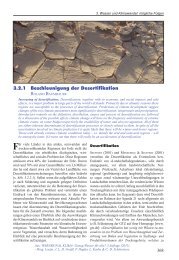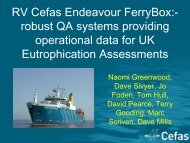Landfills and waste water treatment plants as sources of ... - GKSS
Landfills and waste water treatment plants as sources of ... - GKSS
Landfills and waste water treatment plants as sources of ... - GKSS
You also want an ePaper? Increase the reach of your titles
YUMPU automatically turns print PDFs into web optimized ePapers that Google loves.
<strong>GKSS</strong> 2010/8<br />
<strong>L<strong>and</strong>fills</strong> <strong>and</strong> <strong>w<strong>as</strong>te</strong> <strong>water</strong> <strong>treatment</strong> <strong>plants</strong> <strong>as</strong> <strong>sources</strong> <strong>of</strong> polyfluorinated compounds,<br />
polybrominated diphenyl ethers <strong>and</strong> synthetic musk fragrances to ambient air<br />
(Von der Fakultät III: Umwelt und Technik Institut für Ökologie und Umweltchemie der Leuphana Universität<br />
Lüneburg als Diplomarbeit angenommene Arbeit)<br />
Ingo Weinberg<br />
150 pages with 35 figures <strong>and</strong> 39 tables<br />
Abstract<br />
Polyfluorinated compounds (PFCs), polybrominated diphenyl ethers (PBDEs) <strong>and</strong> synthetic musk<br />
fragrances are frequently used <strong>and</strong> applied in a variety <strong>of</strong> consumer <strong>and</strong> industrial products<br />
<strong>as</strong> surfactants <strong>and</strong> surface coating agents (PFCs), flame retardants (PBDEs) <strong>and</strong> odourous<br />
substances (musk fragrances). Due to their persistence, bioaccumulation potential <strong>and</strong> toxicity<br />
they have been reported to be chemicals <strong>of</strong> emerging environmental concern. However, their<br />
<strong>sources</strong> to the environment are not fully understood yet. All <strong>of</strong> the three substance cl<strong>as</strong>ses were<br />
reported to accumulate in <strong>w<strong>as</strong>te</strong> <strong>water</strong> <strong>treatment</strong> <strong>plants</strong> (WWTPs) or disposed to l<strong>and</strong>fills <strong>as</strong> final<br />
sinks. Several efforts have been made to investigate the fate <strong>of</strong> PFCs, PBDEs <strong>and</strong> musk fragrances<br />
at these potential <strong>sources</strong>. However, the potential for atmospheric rele<strong>as</strong>e w<strong>as</strong> less investigated.<br />
Therefore, the aim <strong>of</strong> this study w<strong>as</strong> to elucidate whether l<strong>and</strong>fills <strong>and</strong> WWTPs can be <strong>sources</strong><br />
for these substances to ambient air.<br />
Airborne PFCs, PBDEs <strong>and</strong> musk fragrances were determined at two l<strong>and</strong>fills <strong>and</strong> two WWWPs<br />
in Northern Germany. Samples were analysed for neutral <strong>and</strong> ionic PFCs (five fluorotelomer<br />
alcohols (FTOHs), three fluorotelomer acrylates, three perfluoroalkylsulfonamido ethanols, three<br />
perfluoralkyl sulfonamides, five perfluorosulfonates <strong>and</strong> nine perfluorocarboxylates), eight PBDE<br />
congeners <strong>and</strong> seven musk fragrances. Air samples were taken simultaneously at reference sites<br />
that were supposed not to be influenced by these potential <strong>sources</strong>. Airborne PFCs, PBDEs <strong>and</strong><br />
musk fragrances were accumulated in cartridges containing polyurethane foam <strong>and</strong> XAD-2 resin<br />
(g<strong>as</strong>-ph<strong>as</strong>e) <strong>and</strong> on gl<strong>as</strong>s fibre filters (particle-ph<strong>as</strong>e).<br />
Results <strong>of</strong> this study suggest that l<strong>and</strong>fills <strong>and</strong> particularly WWTPs are significant point <strong>sources</strong><br />
for musk fragrances ambient air. The source strength <strong>of</strong> the active l<strong>and</strong>fill w<strong>as</strong> higher than for the<br />
inactive l<strong>and</strong>fill for musk fragrances. The source character <strong>of</strong> PFCs at WWTPs <strong>and</strong> l<strong>and</strong>fills w<strong>as</strong><br />
less pronounced. As for the musk fragrances, statistical analysis indicated that FTOHs are mainly<br />
responsible for the significantly elevated PFC g<strong>as</strong>-ph<strong>as</strong>e concentrations observed at l<strong>and</strong>fills <strong>and</strong><br />
WWTPs. The emissions from WWTPs seemed to vary strongly depending on the <strong>w<strong>as</strong>te</strong> <strong>water</strong><br />
contributors <strong>and</strong> the population equivalents <strong>of</strong> the respective <strong>treatment</strong> plant. In contr<strong>as</strong>t to<br />
volatile PFCs, removal <strong>of</strong> ionic PFCs from <strong>w<strong>as</strong>te</strong> <strong>water</strong> by aerosol formation did not appear to be an<br />
important loss mechanism. Air samples were only slightly contaminated with PBDEs displaying low<br />
air contamination in central Europe. Only at one WWTP <strong>and</strong> one l<strong>and</strong>fill significantly elevated<br />
concentrations <strong>of</strong> particle-<strong>as</strong>sociated BDE183 were detected suggesting their origin from these sites.


